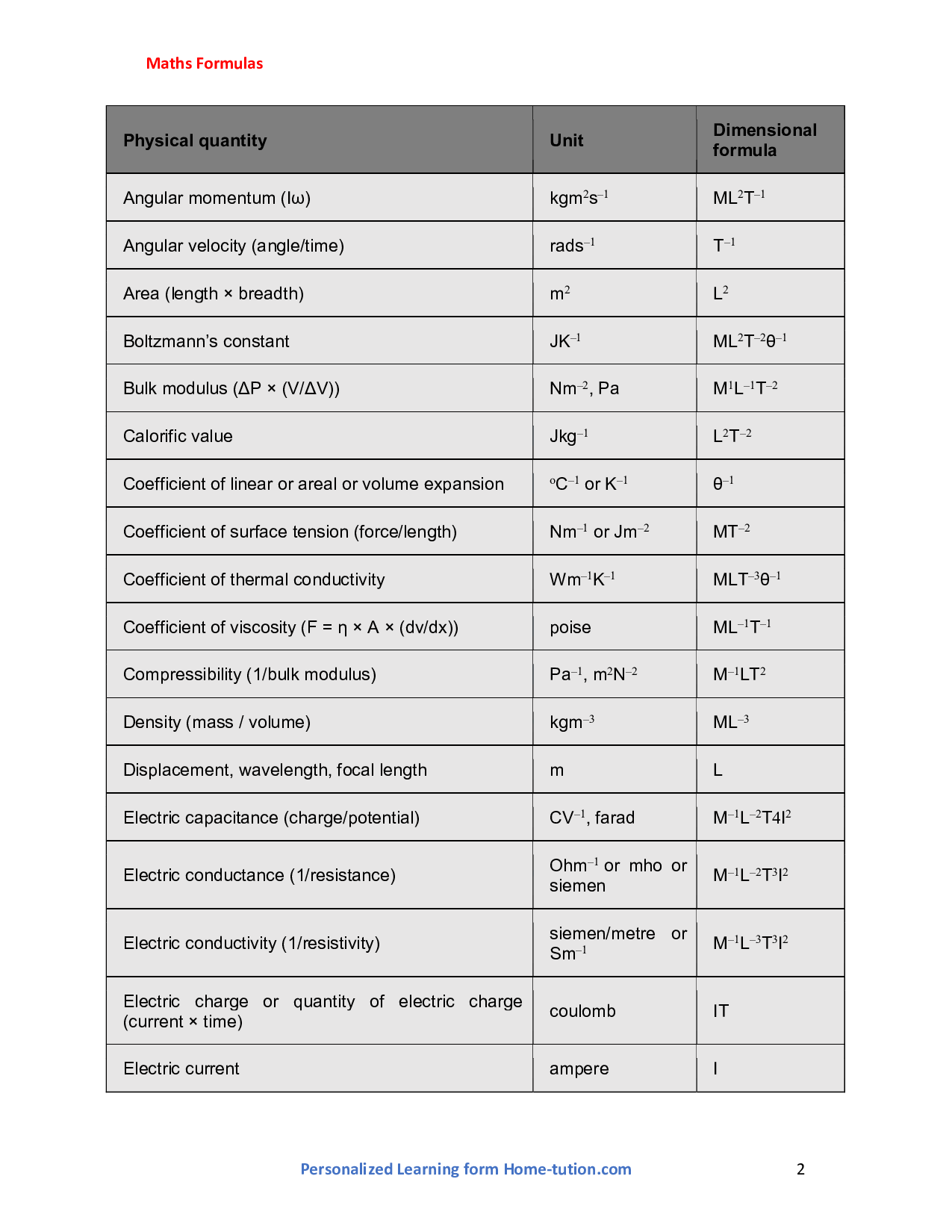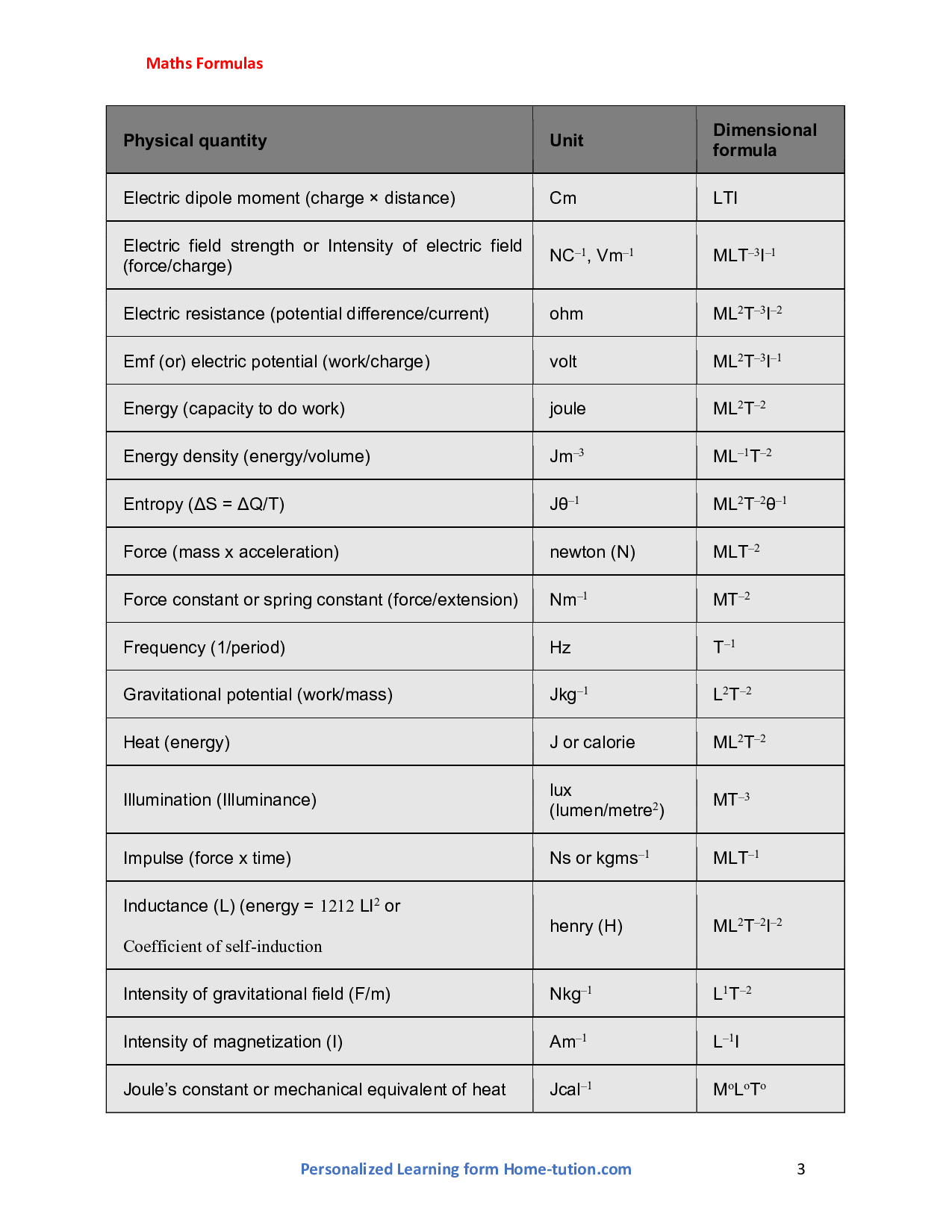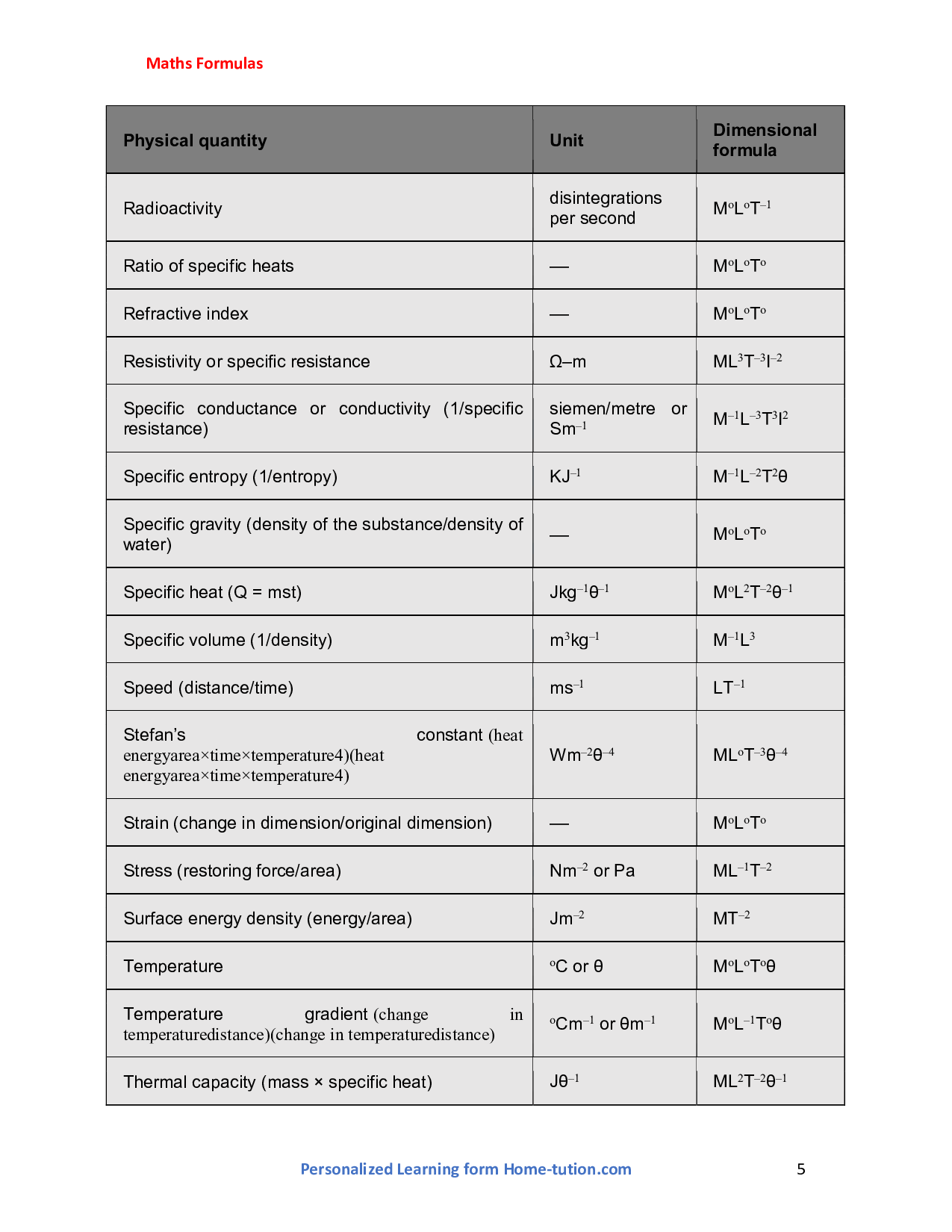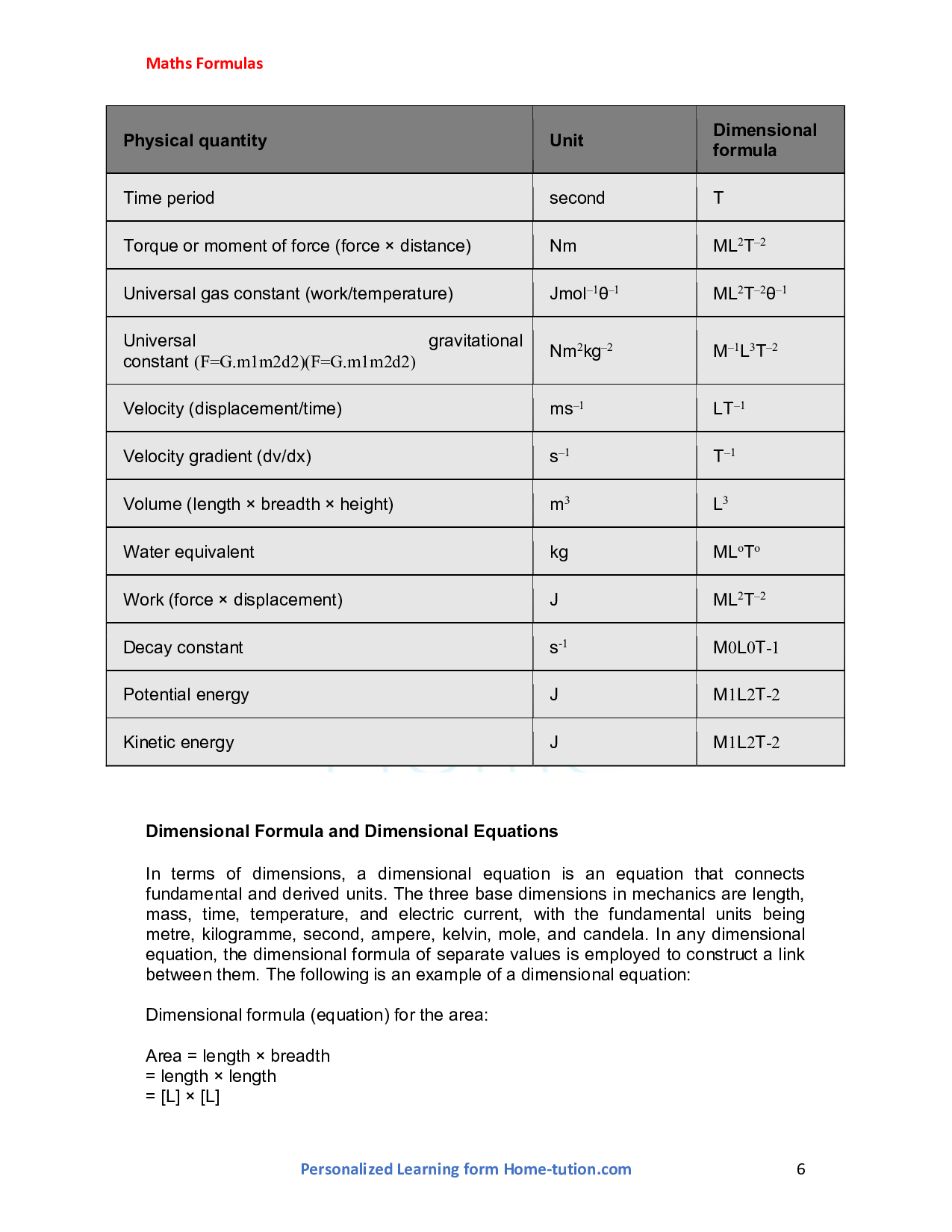Dimensional Formula
About Dimensional Formula
Let us first define dimension before studying the dimensional formula. In math, a dimension is a measurement of length, width, or height extended in one direction. It is a measure of a point / line extended in one direction, according to dimension definition. Every shape in our environment has proportions. In mathematics, there’s no specific dimensional formula for the idea of dimension. The power to which the fundamental units are elevated to obtain one unit of any physical quantity is called its dimension. Let's have a look at the dimensional formula and see some examples at the conclusion. Get the list of Maths Formulas.
What Is the Dimensional Formula?
The phrase expressing the powers to which the fundamental units must be increased in order to obtain 1 unit of a derived quantity is known as the dimensional formula of any quantity. If Q is any physical quantity, the dimensional formula is represented by,
List of Dimensional Formula table
Q = MaLbTc
where M, L, and T are the basic dimensions of mass, length, and time, and a, b, and c are the exponents of each.
| Physical quantity | Unit | Dimensional formula |
|---|---|---|
| Length | m | L |
| Mass | kg | M |
| Time | s | T |
| Acceleration or acceleration due to gravity | ms-2 | LT-2 |
| Angle(arc/radius) | rad | M0L0T0 |
| Angular displacement | rad | M0L0T0 |
| Angular impulse(torque x time) | Nms | ML2T-1 |
| Angular momentum(Iω) | kgm2s-1 | ML2T-1 |
| Angular velocity(angle/time) | rads-1 | T-1 |
| Area(length x breadth) | m2 | L2 |
| Boltzmann's constant | JK-r | M2L2T-2θ-1 |
| Bulk modulus(ΔP X (V/ΔV)) | Nm-2,Pa | M1L-1T-2 |
| Calorific Value | Jkg-1 | L2T-2 |
| Coefficient of linear or areal or volume expansion | 0C-1or K-1 | θ-1 |
| Coefficient of surface tension(force/length) | Nm-1or Jm-2 | MT-2 |
| Coefficient of thermal conductivity | Wm-1K-1 | MLT-3θ-1 |
| Coefficient of viscosity(F = η x A x (dv/dx)) | poise | ML-1T-1 |
| Compressibility(1/bulk modulus) | Pai,m2N-2 | M-1LT2 |
| Density(mass/volume) | kgm-3 | ML-3 |
| Displacement,wavelength,focal length | m | L |
| Electric Capacitance(charge/potential) | CV-1,farad | M-1L-2T4I2 |
| Electric Conductance(1/resistance) | Ohm-1,or mho or siemen | M-1L-2T3I2 |
| Electric Conductivity(1/resistivity) | siemen/metre or Sm-1 | M-1L-3T3I2 |
| Electric charge or quantity of electric charge (current × time) | coulomb | IT |
| Electric current | ampere | I |
| Electric dipole moment (charge × distance) | Cm | LTI |
| Electric dipole moment (charge × distance) | NC-1,Vm-1 | MLT-3I-1 |
| Electric resistance (potential difference/current) | ohm | ML2T-3I-2 |
| Emf (or) electric potential (work/charge) | volt | ML2T-3I-1 |
| Energy (capacity to do work) | joule | ML2T-2 |
| Energy density (energy/volume) | Jm-3 | ML-1T-2 |
| Entropy (ΔS = ΔQ/T) | Jθ–1 | ML2T-2θ–1 |
| Force (mass x acceleration) | newton (N) | MLT-2 |
| Force constant or spring constant (force/extension) | Nm–1 | MT-2 |
| Frequency (1/period) | Hz | T-1 |
| Gravitational potential (work/mass) | Jkg–1 | L2T-2 |
| Heat (energy) | J or calorie | ML2T-2 |
| Illumination (Illuminance) | lux (lumen/metre2) | MT-3 |
| Impulse (force x time) | Ns or kgms-1) | MLT-1 |
| Inductance (L) (energy = LI2 or Coefficient of self-induction |
henry (H) | ML2T-2I-2 |
| Intensity of gravitational field (F/m) | Nkg–1 | L1T-2 |
| Intensity of magnetization (I) | Am–1 | L-1I |
| Joule’s constant or mechanical equivalent of heat | Jcal–1 | M0L0T0 |
| Latent heat (Q = mL) | Jkg–1 | M0L2T-2 |
| Linear density (mass per unit length) | Kgm–1 | ML-1 |
| Luminous flux | lumen or (Js–1) | ML2T-3 |
| Magnetic dipole moment | Am2 | L2I |
| Magnetic flux (magnetic induction x area) | weber (Wb) | ML2T-2I-1 |
| Magnetic induction (F = Bil) | NI–1m–1 or T | MT-2I-1 |
| Magnetic pole strength | Am (ampere–meter) | LI |
| Modulus of elasticity (stress/strain) | Nm–2, Pa | ML-1T-2 |
| Moment of inertia (mass × radius2) | Kgm2 | ML2 |
| Momentum (mass × velocity) | Kgms-1 | MLT-1 |
| Permeability of free space (μo=4πFd2m1m2)(μo=4πFd2m1m2) | Hm–1 or NA-2 | MLT-2I-2 |
| Permittivity of free space (εo=Q1Q24πFd2)(εo=Q1Q24πFd2) | Fm–1 or C2N–1m–2 | M-1L-3T4I2 |
| Planck’s constant (energy/frequency) | Js | ML2T-1 |
| Poisson’s ratio (lateral strain/longitudinal strain) | - | M0L0T0 |
| Power (work/time) | Js-1 or watt(W) | ML2T-3 |
| Pressure (force/area) | Nm-2 or Pa | ML-1T-2 |
| Pressure coefficient or volume coefficient | oC–1 or θ–1 | θ–1 |
| Pressure head | m | M0LT0 |
| Radioactivity | disintegrations per second | M0L0T-1 |
| Ratio of specific heats | - | M0L0T0 |
| Refractive index | - | M0L0T0 |
| Resistivity or specific resistance | Ω–m | ML-3T-3I-2 |
| Specific conductance or conductivity (1/specific resistance) | siemen/metre or Sm–1 | M-1L-3T3I2 |
| Specific entropy (1/entropy) | KJ–1 | M-1L-2T2θ |
| Specific gravity (density of the substance/density of water) | - | M0L0T0 |
| Specific heat (Q = mst) | Jkg–1θ–1 | M0L2T-2θ–1 |
| Specific volume (1/density) | m3kg–1 | M-1L3 |
| Speed (distance/time) | ms-1 | LT-1 |
| Stefan’s constant (heat energyarea×time×temperature) (heat energyarea×time×temperature4) |
Wm-2θ–4 | ML0T-3θ–4 |
| Strain (change in dimension/original dimension) | - | M0L0T0 |
| Stress (restoring force/area) | Nm-2Pa | ML-1T-2 |
| Surface energy density (energy/area) | Jm-2 | MT-2 |
| Temperature | 0C or θ | M0L0T0θ |
| Temperature gradient (change in temperaturedistance)(change in temperaturedistance) | 0Cm-1 or θm-1 | M0L0T0θ |
| Thermal capacity (mass × specific heat) | Jθ-1 | ML2T-2θ-1 |
| Time period | second | T |
| Torque or moment of force (force × distance) | Nm | ML2T-2 |
| Universal gas constant (work/temperature) | Jmol-1θ-1 | ML2T-2θ-1 |
| Universal gravitational constant (F=G.m1m2d2)(F=G.m1m2d2) | Nm2kg-2 | M-1L3T-2 |
| Velocity (displacement/time) | ms-1 | LT-1 |
| Velocity gradient (dv/dx) | s-1 | T-1 |
| Volume (length × breadth × height) | m3 | L3 |
| Water equivalent | kg | ML0T0 |
| Work (force × displacement) | J | ML2T-2 |
| Decay constant | s-1 | M0L0T-1 |
| Potential energy | J | M1L2T-2 |
| Kinetic energy | J | M1L2T-2 |
Dimensional Formula and Dimensional Equations
In terms of dimensions, a dimensional equation is an equation that connects fundamental and derived units. The three base dimensions in mechanics are length, mass, time, temperature, and electric current, with the fundamental units being metre, kilogramme, second, ampere, kelvin, mole, and candela. In any dimensional equation, the dimensional formula of separate values is employed to construct a link between them. The following is an example of a dimensional equation:
Dimensional formula (equation) for the area:
Area = length × breadth
= length × length
= [L] × [L]
= [L]2
⇒ Dimensional formula (equation) for area (A) = [L2 M0 T0]
Applications of Dimensional Formula
It is used to verify the correctness of an equation. It is used to derive the relationship between different physical quantities. It is used to convert from one system of units to another for any given quantity.
Download the pdf of the Dimensional Formula







Related Links
- A plus B Whole Square
- A Plus B Whole Cube Formula
- A Minus B Whole Square
- A minus B Whole Cube Formula
- X plus 1 whole cube Formula
- 2cosA cosB Formula
- 3D Distance Formula
- 30-60-90 Formula
- 90 Degree Angle Formula
- a3 plus b3 Formula
- a3 - b3 Formula
- a2+b2+c2 Formula
- Addition Formula
- All Algebra Formula in One sheet
- Algebraic Sequence Formula
- All Circle Formulas
- Altitude of a Triangle Formula
- Amplitude Formula
- Angle Bisector Theorem
- Angle Difference Formula
- Angles Formulas
- Annuity Formula
- ANOVA Test
- Antiderivative Formula
- APY Formula
- Arccot Formula
- Arc Length
- Arctan Formula
- Area of a circle
- Area of a sector of a circle formula
- Area under the curve formula
- Arithmetic Sequence Recursive Formula
- Arithmetic Mean Formula
- Arithmetic Sequence Explicit Formula
- Arithmetic Sequence Formula
- ASA Formula
- Associative Property Formula
- Asymptote Formula
- A Union B Formula
- Average Deviation Formula
- Average Formula
- Average Rate of Change Formula
- Average speed formula
- Axis of the Symmetry
- Basic Algebra Formula
- Cosec Cot Formula
- Baye's Formula
- Binary to Decimal
- Binomial Distribution Formula
- Binomial Expansion
- Binomial Theorem Formula
- Calculus formulas
- Calculus Formulas
- Celsius Formula
- Celsius to Fahrenheit
- Celsius to kelvin
- Centimeter Square to Meter Square Formula
- Central Angle of a Circle Formula
- Central Limit Theorem
- Central Tendency Formula
- Centroid Formula
- Centroid of a Trapezoid Formula
- Chain Rule And Composite Functions
- Change of Base Formula
- Chi-square formula
- Circle Graph Formula
- Clock Angle Formula
- Coefficient of Variation
- Cofactor Formula
- Coin Toss Probability Formula
- Combinations Formula
- Common Ratio Formula
- Commutative Property Formula
- Completing the Square Formula
- Complex Number Formula
- Conditional probability Formula
- Cone Height Formula
- Confidence Interval Formula
- Consecutive Integers Formula
- Continuous Compounding Formula
- Convert Millimeter to Inches Formula
- Correlation Coefficient Formula
- Cos Inverse Formula
- Cos Square Theta Formula
- Cosecant Formula
- Cost Price Formula
- Cot-Tan Formula
- Cotangent formula
- Covariance Formula
- Cpk Formula
- Cross product formula
- Cube formula
- Cube Root Formula
- Cubic Equation Formula
- Degrees to Radians
- Double Angle Formulas
- Quadratic Function
- Quadrilateral Area Formulas
- Quadrilateral Formulas
- Quarterly Compound Interest Formula
- Quartile Formula
- Quarts to liters formula
- Quotient Rule Formula
- R Squared Formula
- Radians to Degrees
- Radical
- Radius of Curvature Formula
- Radius
- Range Formula
- Rate formula
- Rate of Change Formula
- Rate of Return Formula
- Ratio Analysis Formulas
- Ratio Formula
- Rational Numbers Formula
- Reciprocal Formula
- Recursive Formula
- Reduction Formula
- Regular Hexagon Formula
- Relative Change Formula
- Relative Error Formula
- Relative Frequency Formula
- Relative Standard Deviation Formula
- Remainder Formula
- Lagrange Interpolation Formula
- Lateral Area Formula
- Lateral Surface Area of a Cube
- Law of Cosines
- Law of Sines
- Least Common Multiple
- Limit Formula
- Linear Approximation Formula
- Linear Equation Formula
- Linear Function Formula
- Linear Interpolation Formula
- Litres to gallons formula
- Log Formulas
- Factorial
- Factoring Trinomials Formula
- Factorization Formula
- Fahrenheit Equation
- Fahrenheit to Celsius
- Fahrenheit to Kelvin
- Fibonacci Sequence Formula
- Fibonacci Sequence
- Foil Formula
- Foot To Meter Formula
- Formula For 180 Degree Rotation
- Formula For Absolute Value
- Formula For Adding Fractions
- Formula For Adding Consecutive Numbers
- Formula Arc Length
- Formula For Dividing Fractions
- Formula For Finding Angles
- Formula For Odd Numbers
- Formula For Period
- Formula For Squaring
- Isosceles Triangles Formulas
- Formula To Find x Intercept
- Fourier Series Formula
- Fractions Formula
- Frequency Distribution Formula
- Frequency Formula
- Frustum Of A Regular Pyramid Formula
- Frustum of Cone
- Function Formulas
- Function Notation Formula
- Future Value Compound Interest Formula
- Future Value Simple Interest Formula
- G To Kg Formula
- GCD Formula
- GCF Formula
- Geometric Area Formula
- Geometric Distribution Formula
- Geometric Mean Formula
- Geometric Sequence Formulas
- Geometric Series Formula
- Geometric Sum Formula
- Geometry Formulas
- Gradient Of A Line
- Grams To Kilogram Formula
- Great Circle Formula
- Gross Profit Formula
- Half Life Formula
- Harmonic Mean Formula
- HCF Formula
- Height Of A Parallelogram Formula
- Heron's Formula
- Hexadecimal To Decimal Formula
- Hexagon Formula
- How To Convert 20 Celsius Into Fahrenheit
- How To Convert Celsius Into Fahrenheit
- Hyperbola Formula
- Hyperbolic Functions Formula
- Hypotenuse Formula
- Implicit Differentiation Formula
- Independent Events Formula
- Infinite Geometric Series Formula
- Infinite Series Formula
- Integers Formulas
- Integration By Parts Formula
- Integration Formulas
- Integration of UV Formula
- Interest Formula
- Interest Rate Formula
- Interior Angle Formula
- Internal Rate of Return Formula
- Linear Interpolation Formula
- Interquartile Range(IQR) Formula
- Inverse Functions
- Inverse of Matrix
- Inverse Tangent Formula
- Inverse Trigonometric Formulas
- Inverse Variation Formula
- Inversely Proportional Formula
- Perimeter Of The Isosceles Triangle
- Sample Mean Formula
- Sample Size Formula
- Sample Standard Deviation Formula
- Sample Variance
- SAS Triangle Formula
- Scalene Triangle
- Scientific Notation Formula
- Secant Formula
- Selling Price Formula
- Long Division Formula
- Sequences and Series Formulas
- Semicircle Formulas
- Sequence Formulas
- Maclaurin Series Formula
- Magnitude of a Vector
- Sets Formulas
- Magnitude of Vector formula
- P(A/B) Formula
- Matrix Formula
- Mean Absolute Deviation Formula
- Parabola Formula
- Mean Deviation
- Parallel Lines Formula
- Parallelogram Formula
- Mean formula
- Pearson Correlation Formula
- Percent Composition Formula
- Mean Median Mode Formula
- Mean Value Theorem
- Median
- Midpoint Formula
- Miles to Km formula
- Percent Decrease Formula
- Measurement Formulas
- Miles to meter formula
- Percent Error
- Percent Difference Formula
- Percent Yield
- ml to l Formula
- Percentage Increase Formula
- Mode
- Monthly Compound Interest Formula
- Mph to m/s formula
- Percentile Formulas
- Multiple Angle Formulas
- Multiplication
- n Choose k Formula
- Perfect Cube Formula
- Natural Log Formula
- Perfect Square Formula
- NCR Formula
- Perfect Square Trinomial Formula
- Net Change Formula
- Net Income Formula
- Net Present Value Formula
- Perimeter Formulas
- Net Worth Formula
- Newton's Method Formula
- Nominal Interest Rate Formula
- Normal Distribution Formula
- nPr Formula
- Ordinary Annuity Formula
- Orthocenter Formula
- Perimeter Of A Circle Formula
- Z Score
- Perimeter Of A Kite Formula
- Perimeter of a Trapezoid Formula
- Yards to Meters Formula
- Permutation And Combination
- Y-Intercept
- Permutation Formula
- Work Formula
- What are Trigonometric Functions Formulas
- Weight formula
- Perpendicular Line Formula
- Phase Shift Formula
- Weighted Mean
- Weighted Average
- Pi Formula
- Point of Intersection Formula
- Washer Method Formula
- Point Slope Form
- Volume Formulas
- Vieta's Formula
- Venn Diagram Formula
- Vector Projection
- Vector formulas
- Poisson Distribution Formula
- Polygon Formula
- Polynomial Formula
- Variance Formula
- U Substitution Formula
- Unit Vector
- Population Change Formula
- Unit Rate Formula
- Unit Conversion
- Unit Circle
- Uniform Distribution Formula
- Population Mean Formula
- Trigonometry Formulas
- Triangular Pyramid Formula
- Triangle Formulas
- Trapezoidal Rule
- Trajectory Formula
- Total Interest Formula
- Time Formula
- The direction of a vector
- The Accuracy Formula and How to Calculate It
- Temperature Conversion
- T Distribution Formula
- Taylor Series Formula
- Taylor Polynomial Formula
- Tangent Line
- Tangent Formulas
- Tangent Circle Formula
- Tan Formula
- Tan2x Formula
- Surface-area-of-triangular-pyramid-formula
- Surface Area of a Square Prism
- Surface Area Formulas
- Supplementary Angles Formula
- Sum of Squares
- Sum of Perfect Squares Formula
- Sum of n Natural Numbers Formula
- Sum of Integers Formula
- Sum of Exterior Angles Formula
- Sum of Even Numbers Formula
- Sum of Cubes Formula
- Sum of Arithmetic Sequence Formula
- Sum of Angles Formula
- Summation Formulas
- Subtraction
- Stirling Formula
- Standard Form Formula
- Standard Deviation
- SSS Formula
- Square Root
- Square Footage Formula
- Speed formula
- Special Right Triangles
- Special Factoring Formulas
- Slope of the Secant Line Formula
- Slope Intercept Form
- Slope Formula
- Slant Height Formula
- Skewness Formula
- Sin Squared x Formula
- Sin Formula
- Sine Formula
- Sin Cos Tan
- Sin Cos Formulas
- Sin2x Formula
- Simpson's Rule
- Simple Interest
- Similar Triangles Formula
- Signal to Noise Ratio
- Sides of Triangle
- Shell Method Formula
- Rotation Formula
- Root Mean Square Formula
- Rise Over Run Formula
- Right Angled Triangle
- Riemann Sum Formula
- Rhombus Formula
- Reverse Percentages
- Revenue Formula
- Resultant Vector Formula
- Remainder Theorem
- Profit Margin Formula
- Profit Formula
- Profit and loss formula
- Product To Sum Formulas
- Area of Square Formula
- Product Rule
- Area of Trapezoid
- Basic Statistics Formula
- Current Formula
- Daily Compound Interest Formula
- De Moivre's Formula
- Exponential Decay Formula
- Decimal to Binary Formula
- Decimals Formula
- Definite Integral Formula
- Derivative Formula
- Diagonal of a Cube Formula
- Diagonal of a Parallelogram
- Diagonal of a Polygon Formula
- Diagonal of The Rectangle
- Probability Formula
- Prime Numbers Formula
- Diagonal of the Square
- Diagonals Formula
- Prime Factorization Formula
- Present Value Formula
- Present Discounted Value Formula
- Population Variance
- Diameter Formula
- Km to miles formula
- Diameter Of A Sphere Formula Using Volume
- Kilogram to newton formula
- Exterior Angle Theorem
- Difference of Cubes Formula
- Exponential Formula
- Difference of Squares Formula
- Exponential Growth Formula
- Exponential growth and decay formula
- Exponential Function formula
- Exponential Function
- Side Angle Side Formula
- Difference Quotient Formula
- Differential Equation Formula
- Dimensional Formula
- Discriminant Formulas
- Disk Method Formula
- Distance Formula
- Distributive Property Formula
- Exponential Equations
- Dividend Divisor Quotient Remainder Formula
- Exponential Distribution
- Exponential Decay Formula
- Division Formula
- Euler's Formula
- Expected Value Formula
- Dot product
- Euclidean Distance Formula
- Double Angle Formulas
- Equilateral Triangle Formula
- Equation of a circle formula
- Endpoint Formula
- Double Time Formula
- Empirical Rule Formula
- Empirical Probability Formula
- Ellipse Formulas
- Effective Interest Rate Formula
- Effective Annual Rate Formula
- Differentiation and Integration Formula
- Direct Proportion Formula
- Direct Variation Formula
- a2-b2 Formula
- Discount Formula
- Determinant Formula
- Pythagorean Triples Formula
- P-value Formula
- Proportion Formula
- P(A intersections B) Formula
- P(A union B)Formula
- Decimal to Hexadecimal
- Vertex Formula
- Area of Octagon
- Outlier Formula
- Distance Between Two Points Formula